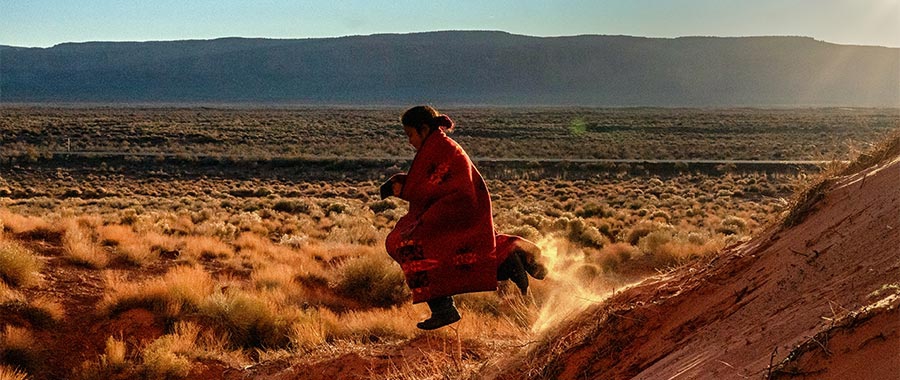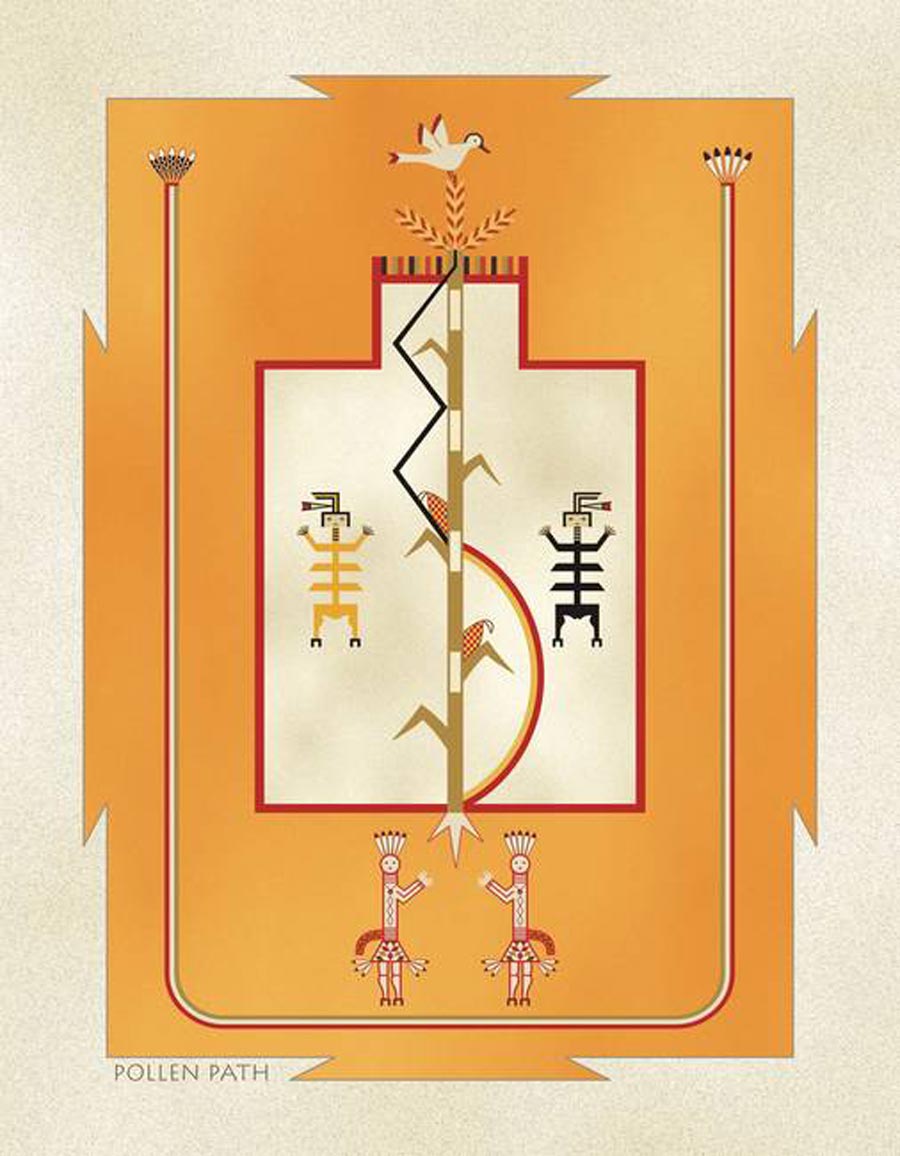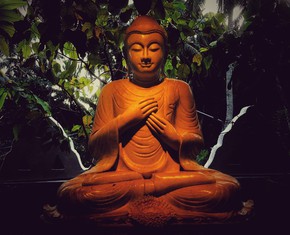The views expressed in our content reflect individual perspectives and do not represent the authoritative views of the Baha'i Faith.
In these next two essays, Chris Buck continues his deep spiritual conversation with Navajo Baha’i Bitahnii Wayne Wilson about the Diné holy traditions and their congruence with the Baha’i teachings.
Q: Greetings, brother Bitahnii! Earlier today, you sent me a very interesting Navajo sand painting, which was actually displayed on the cover of a book published by Stanford University Press. This sand painting is featured not only on the book cover itself, but also as the frontispiece for the book. The text of the frontispiece reads:
The Pollen Path: A Sand Painting from the Blessing Way Chant Cycle
The Initiate enters the path of the rainbow at the lower right, passes onto the yellow pollen path between the two mysterious Ethkaynaáshi Spirit Bringers, and comes into the white field of ritual ceremony through the Navajo tree of life, the Great Corn Plant. He has to pass through both female and male experience as he does so, the female experience symbolized by the smooth, curved lines of the rainbow (red and blue), and the male by the crooked, dynamic lines of the lightning. Passing out at the top through the corn tassels, he comes to the Blue Bird, which signifies blessing and peace, and goes out into the world again on the yellow pollen path at upper right.” – Margaret Schevill Link, The Pollen Path: A Collection of Navajo Myths, Frontispiece.
A: That’s good you found it, Chris! It kind of reminds me of how you have begun on a new spiritual journey.
Q: Yes, I have—thanks to you! Is this sand painting known by any other name?
A: It’s called the “Rainbow and Corn Pollen Path.”
Q: These sand paintings, as I understand it, are utilized in healing ceremonies done by Navajo medicine men—a remarkable coming-together of art, culture and medicine. In your own Navajo spiritual life, have you encountered this “Rainbow and Corn Pollen Path” sand painting before?
A: Yes, I’ve seen this version—it was done over me, but not in sand painting form. When I say “done over me,” I mean that this same “Rainbow and Corn Pollen Path” design was done in ground white corn on a buckskin that was not slayed by a bullet or arrow in a sacred ceremony I took part in.
The sand painting is from a unique ceremony—but one that isn’t done as much anymore. The author, Margaret Schevill Link, used this sand painting only to promote her book. This sand painting used to be used with the Blessing Way ceremony, but it was changed or isn’t being done anymore because of how the author has used it to promote the book.
Q: I see. I also see that the “Pollen Path” is commercially available, with this description:
Design based on a traditional Navajo sand painting known as the Pollen Path. This shows two Yei (supernatural beings) assisting in bringing nourishment from the ground up through the roots into the corn plant. In the corn field two additional beings represent the balanced forces of day-night and rainbow-lightning. Sky bird is perched on top of the tassels and the entire scene is framed by a rainbow protection border, left open at the top for beneficial forces to enter. – Artist, Kenny Bakeman, Pollen Path
A: This rendition of the sand painting is not complete because we Diné/Navajo purposely leave it incomplete, unless one is having the ceremony performed over them, when the sand painting is then completed as part of the healing ceremony. So that’s why it was used on the book cover, since tradition dictates that a complete sand painting must be destroyed, once the ceremony for which it was used is done.
Q: There are many Navajo/Diné sand paintings. Why did you choose this one?
A: I chose that particular design to explain to my elders and other people in general spiritual teachings about the process of renewal, and about how the patient—who wants harmony (hozho) to be restored within their mind, body, and soul—can start over and new again, after the ceremony is over. It also reminds me of the Baha’i teachings regarding the establishment of peace and harmony in the world:
O ye lovers of God! Make firm your steps; fulfil your pledge to one another; go forth in harmony to scatter abroad the sweet savours of God’s love, and to establish His Teachings, until ye breathe a soul into the dead body of this world, and bring true healing in the physical and spiritual realms to everyone who aileth. – Abdu’l-Baha, Selections from the Writings of Abdu’l-Baha, p. 244.
Q: I understand that this sand painting comes from the Blessing Way tradition. I also understand that corn is central to Navajo life, and that corn pollen is the essence. For that reason, corn pollen is an essential part of Diné/Navajo life, including all of the sacred ceremonies. Is the description in the caption to the Frontispiece above generally accurate?
A: This sand painting is not now, or is rarely, performed during the Navajo Blessing Way or Beauty Way ceremonies. Also, this sand painting is not of the Nine-Night Way. This is how my elders explained this particular sand painting to me:
As our spirit is traveling from another world, we are traveling on the Rainbow Path. Before you approach the Holy Grandfathers, you see four footprints that lead to the Holy Grandfathers who are there and who grant you renewal and reawakening. As you take the next four steps up the Corn Stalk, you’re reborn into another world making the next four steps as you experience the ugly and beautiful sides of life that help you to spiritually develop. The Corn Stalk represents enduring the hardships of life and living a beautiful life—from birth into the transformation of old age.
That is where the Spirit Guides come into your life and instruct you on how you’re living your life right or wrong, as you’re beginning to reflect the spiritual processes in order to develop your spiritual capacity.
In other words, the Rainbow Path consists of going on a spiritual journey, which is seen on the sand painting itself, that shows the rainbow with four footprints leading to the Holy Grandfathers. Then you start by going up the Corn Stalk, developing and relearning what we call Hozho—peace, beauty, balance, and harmony, experiencing your feminine essence, then the masculine essence, as you ascend the Corn Stalk. At the top of the Corn Stalk is the final stage of enlightenment, as the result of being transformed, by walking upon the pollen path. The bird at the top represents spiritual sovereignty.
Like all other sand paintings, this “Rainbow and Corn Pollen Path” is considered a visual prayer that tells us how to live in hozho on this Mother Earth and throughout the many worlds of God—through time and eternity. So this sand painting depicts the visual spiritual process of reaching the highest potential and capacity in one’s spiritual development.
I’m sharing with you some of my Navajo spiritual knowledge and philosophy that reflects the Baha’i spiritual teachings, through my life experiences of this Navajo ceremony, and others as well.

















Comments
Sign in or create an account
Continue with Googleor